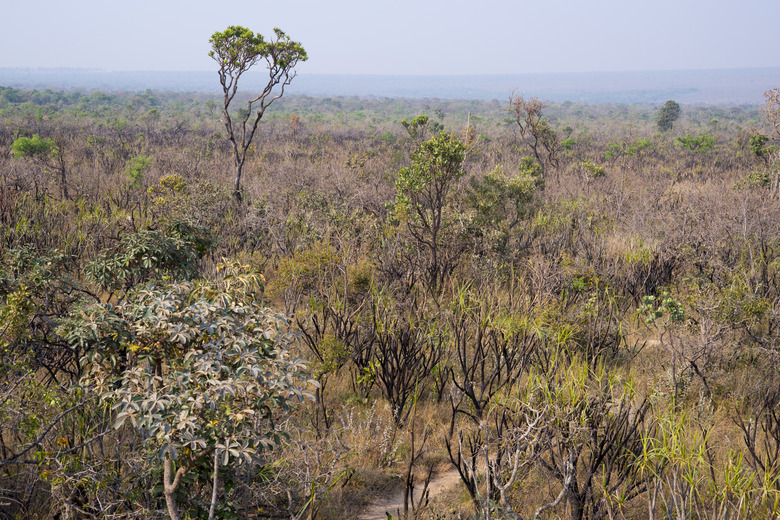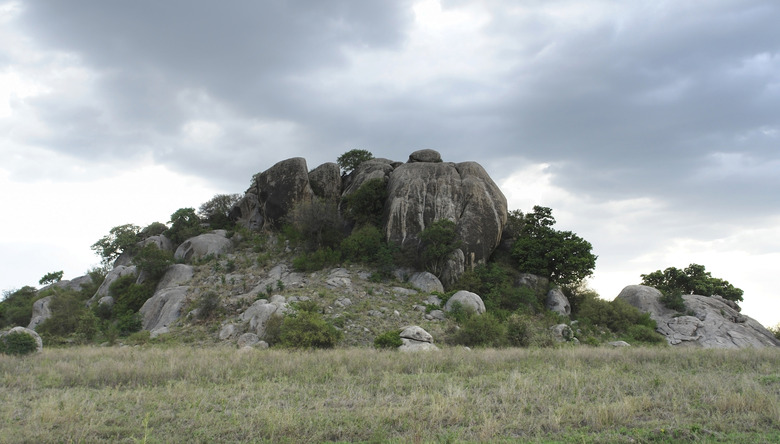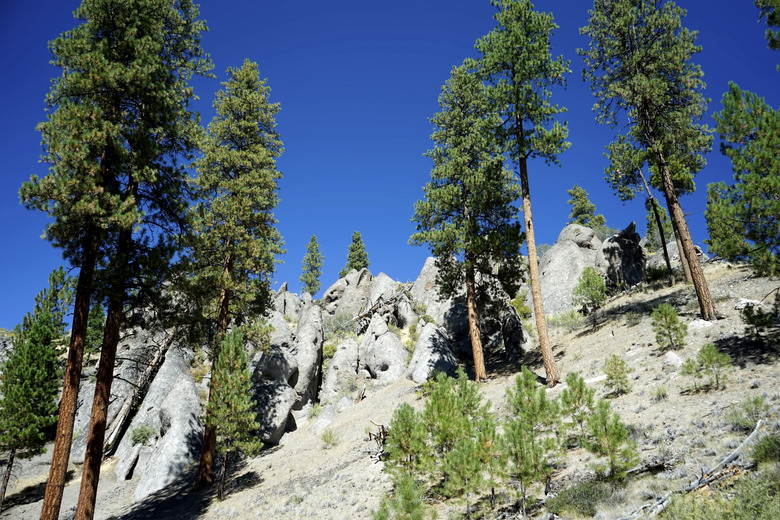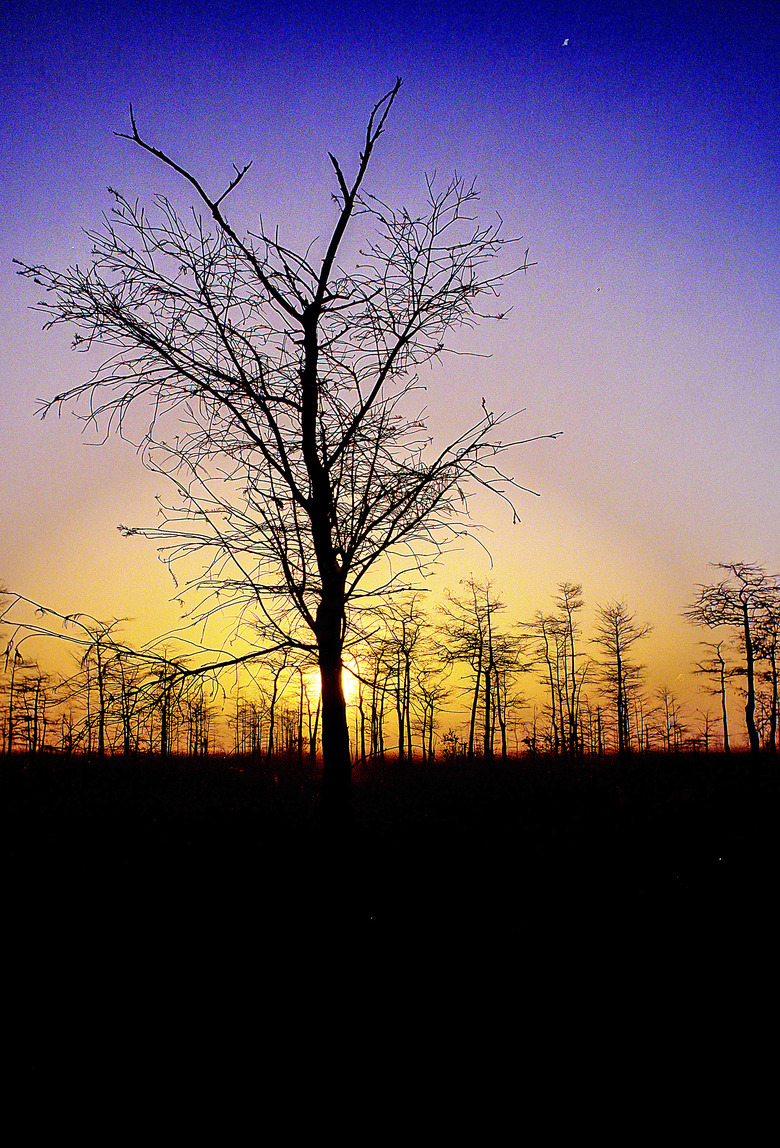Landforms Of A Savanna
A savanna — the term stems from the Spanish variant, "zavana," of a Taino word meaning grassy flat — refers to a landscape dominated by grasses and trees of varying densities but too widely spaced to form a closed canopy. Savannas are actually considered to be a subtype of biome/habitat under the broader classification of grassland biomes.
Read more about the general characteristics of the savanna biome.
Widespread in the tropics of Africa, Asia, South America and northern Australia, grassland biomes and savannas also appear in temperate latitudes: the pine savannas of the southeastern United States, for example. At both large and small scales, savanna landforms wield important ecological influence for plants, animals and other organisms that live in these environments.
Large-Scale Savanna Landforms
Large-Scale Savanna Landforms
Some of the largest areas of tropical savanna landscape have developed on the level plains and plateaus of continental shields, exposures of ancient Precambrian rock. While climate — especially rainfall patterns — and fire regimes can play a major role in the establishment and persistence of savannas, the influence of soil, the "edaphic" factor, is often hugely important in these areas.
These old soils, deeply weathered and leached, are often nutrient-poor, and many exhibit an impermeable subsurface layer called a lateritic crust that diminishes their water-holding capacity. These characteristics often discourage forest growth and instead foster plentiful grasses and scattered trees or shrubs.
Isolate Hills and Mountains
Isolate Hills and Mountains
"Inselbergs" describe isolated mountains or outcrops. While these can be encountered in many different settings, they are particularly prominent in arid and semi-arid savanna landscapes. They owe their topographic stature to differential erosion.
East Africa's Serengeti Plains are dotted with inselbergs, regionally called "kopjes," from the Dutch/Afrikaans word for "little head." These are jumbled, cleft outcrops of Precambrian granite, diorite or gneiss exposed as erosion removes overlying layers of less-resistant rock. The small area covered by kopjes belies their ecological importance. The rocks' crevice-pooled water and relative immunity to fire allow denser thickets and trees to establish.
Certain animals, such as hyraxes and the nimble antelope called klipspringers, are specially adapted for the rugged kopje microenvironment, while carnivores such as lions and cheetahs often use them as vantages for scouting prey.
Foothills and Escarpments
Foothills and Escarpments
At the biome scale, savannas represent climate-, soil- and/or fire-dictated thresholds between forest and grassland biomes. This can be true at the scale of the savanna landscape as well. In mountainous country in dry, temperate regions, savannas often form a transitional belt between lower steppe and higher montane forest. In the American West, pine or juniper savannas also develop along escarpments rising from shrub- or bunchgrass steppe.
The coarse-textured soils of such landforms retain more moisture than the fine-textured ones of the surrounding plains, allowing ponderosa and limber pines as well as junipers to grow. Additionally, limber pines may form savanna-woodlands on escarpments because jays and Clark's nutcrackers are more likely to cache pine seeds there, where winter snow accumulations are patchier than on the shrub- or grasslands below.
Floodplain and Wetland Savannas
Floodplain and Wetland Savannas
In both temperate and tropical regions, savannas may also establish on floodplains and in low-lying basins supporting seasonal wetlands, where regular flooding prevents the existence of heavier woodland or forest. Subject to the hydrological fluctuations of wet and dry seasons, many of the world's tropical and subtropical wetlands — the Everglades, the Pantanal, the Sudd, the Okavango — include savannas as part of their ecological matrix.
Tolerant of occasional flooding, palms often form savannas in wetland complexes from Florida to the South American Llanos. In North America, willows, ashes and other bottomland hardwoods seasonally inundated in swamps or marshes may create floodplain savanna landscapes when waters retreat.
References
- Savannas, Barrens, and Rock Outcrop Plant Communities of North America; Roger C. Anderson, et al. (eds.)
- Radford University Department of Geospatial Science: Biomes of the World — Tropical Savannas
- Forest Ecosystems; David A. Perry, et al.
- Earth Science Picture of the Day: The Simba Kopjes of East Africa's Serengeti Plains
- Safari Ecology: Kopjes
Cite This Article
MLA
Shaw, Ethan. "Landforms Of A Savanna" sciencing.com, https://www.sciencing.com/landforms-savanna-8542928/. 29 July 2019.
APA
Shaw, Ethan. (2019, July 29). Landforms Of A Savanna. sciencing.com. Retrieved from https://www.sciencing.com/landforms-savanna-8542928/
Chicago
Shaw, Ethan. Landforms Of A Savanna last modified August 30, 2022. https://www.sciencing.com/landforms-savanna-8542928/




